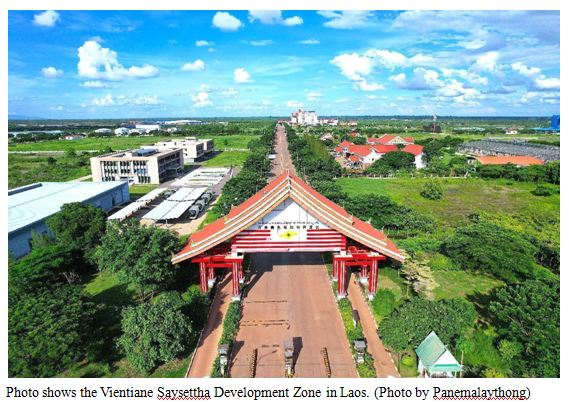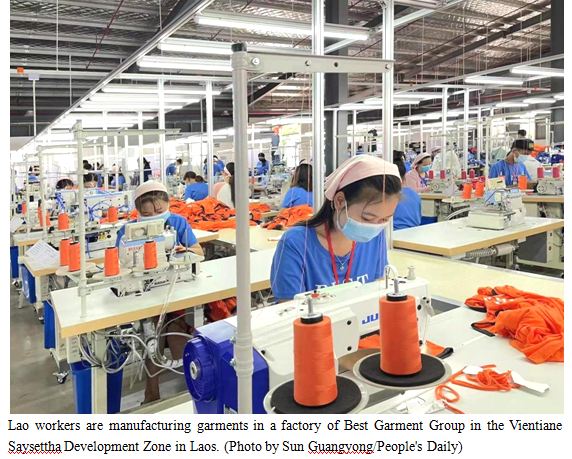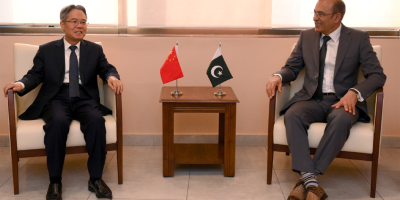China-Laos cooperation bears fruits in Vientiane Saysettha Development Zone

By Sun Guangyong, Zhang Jinruo, Yu Yichun, Hu Zexi, People’s Daily
About a 30-minute drive northeast of downtown Vientiane, the capital of Laos, there lies the Vientiane Saysettha Development Zone (SDZ), with factories neatly arranged.
It is the only state-level overseas economic and trade cooperation zone established by China in Laos, as well as Lao’s national-level special economic zone.
As an early fruit of the Belt and Road Initiative (BRI), the SDZ plays an important role in promoting Laos’ industrialization and fostering China-Laos economic cooperation.
Chinese garment enterprise Best Garment Group has a 20,000-square-meter factory in the SDZ. In the factory workshop, local workers were busy on production lines to make garments for export to Europe.
“We have introduced advanced automated cutting machines and computerized sewing equipment, carried out training, and adopted lean production management and production execution systems. We are committed to building a first-class clothing factory in Laos,” said the general manager of the factory Sun Linhua.
Headquartered in east China’s Jiangsu province, Best Garment Group established its Lao branch in the development zone two years ago. The factory has 40 production lines and hires 2,000 employees, with a designed annual production capacity of 20 million sets of various knitted garments sold to European, American and Japanese markets.
So far, the SDZ has attracted 131 companies from China, Japan, Singapore, Thailand and other countries and regions, with a total investment of over $1.5 billion, creating 6,000 jobs. After all the companies currently stationed in the zone come into operation, the SDZ is expected to generate a total output value exceeding $1.8 billion each year and create more than 10,000 jobs.
“The SDZ has introduced many well-known enterprises, bridging the gap in a number of manufacturing sectors in Laos such as electronics manufacturing, biomedicines, agricultural product processing and textiles. This has played a significant role in promoting the overall industrial development of the country,” said the director of the investment service center of the SDZ.
Blue new energy vehicles, white new energy buses and trucks are always seen running on the roads in the development zone, where solar-powered smart streetlights are lined on both sides of the road. These 3,000 sets of streetlights were all manufactured in China.
The Saysettha Low-Carbon Demonstration Zone is a cooperation project jointly launched by China and Laos in the SDZ to address climate change in the framework of South-South cooperation. It is one of the 10 low-carbon demonstration zones built by China in other developing countries.
According to a memorandum of understanding signed between China and Laos, the two sides will launch a series of cooperation, including promoting a low-carbon lifestyle through low-carbon transportation and improving green infrastructure construction through low-carbon lighting.
“We hope that the Saysettha Low-Carbon Demonstration Zone can gain valuable experience in green development for other parts of Laos,” said Bounkham Vorachit, Minister of Natural Resources and Environment of Laos.
The demonstration zone plays an important role in helping Laos achieve the goal of net zero emissions by 2050, and will strongly promote the sustainable economic and social development of Laos, she added.
The Vientiane South Station of China-Laos Railway, ten kilometers away from the SDZ, showed a busy scene. Lao agricultural products and manufacturing goods were on their way to China along the railway.
Since the opening of the China-Laos Railway in December 2021, the SDZ has embraced better development. It is reported that the development zone has a customs service center, where goods manufactured by enterprises in the zone can be exported to China through various transportation methods after completing customs clearance procedures.
With more convenient logistics and significantly lowered costs, the advantages have become more prominent in the SDZ, and many enterprises there were planning to expand their production.
With the implementation of the Regional Comprehensive Economic Partnership (RCEP) in January 2022, foreign-invested enterprises in the SDZ can enjoy more favorable policies.
The head of Laos Alliance Pharmaceutical Group said that the implementation of the RCEP has reduced the company’s production and sales costs, and it is more convenient for enterprises in the SDZ to process and export products.
Sommad Pholsena, vice president of the Lao National Assembly, said he hoped the SDZ would be built into a model for Laos’ special economic zones, and expected Laos and China to continue strengthening relevant cooperation and drive the development of small and medium-sized enterprises, so as to assist Laos in industrial upgrading, and benefit more Lao people.

Related News

China wants to ensure Afghan gov’t participation in SCO meet
ISLAMABAD, May 29 (DNA): China wants the Afghan interim government attends the upcoming Shanghai CooperationRead More

Chinese Ambassador visits NUST; Calls for deeper Sino-Pak academic ties
ISLAMABAD , MAY 29 (DNA):Marking a momentous step forward in deepening bilateral academic cooperation, HERead More


Comments are Closed